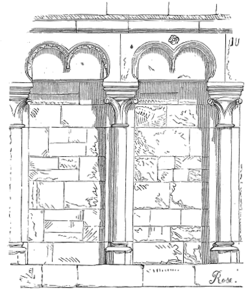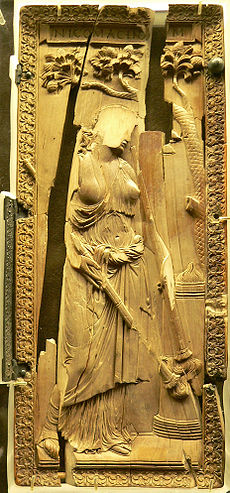
Montier-en-Der Abbey
Encyclopedia

Haute-Marne
Haute-Marne is a department in the northeast of France named after the Marne River.-History:Haute-Marne is one of the original 83 departments created during the French Revolution on March 4, 1790...
, France
France
The French Republic , The French Republic , The French Republic , (commonly known as France , is a unitary semi-presidential republic in Western Europe with several overseas territories and islands located on other continents and in the Indian, Pacific, and Atlantic oceans. Metropolitan France...
) was formerly a Benedictine, later Cluniac, abbey, dissolved during the French Revolution
French Revolution
The French Revolution , sometimes distinguished as the 'Great French Revolution' , was a period of radical social and political upheaval in France and Europe. The absolute monarchy that had ruled France for centuries collapsed in three years...
, the grounds and premises of which, since 1806, have been used as the French National Stud Farm
Stud farm
A stud farm or stud in animal husbandry, is an establishment for selective breeding of livestock. The word "stud" comes from the Old English stod meaning "herd of horses, place where horses are kept for breeding" Historically, documentation of the breedings that occur on a stud farm leads to the...
.
Monastery
The monastery was founded in about 670, in deep oak forest on the banks of the river Voire, at a place that at first still carried its Gallo-Roman name of Puteolus ("little well") in the diocese of Châlons-sur-Marne. The site, which must have been an aristocratic Gallo-Roman villaRoman villa
A Roman villa is a villa that was built or lived in during the Roman republic and the Roman Empire. A villa was originally a Roman country house built for the upper class...
, to judge from the quality of the ivory diptych
Diptych
A diptych di "two" + ptychē "fold") is any object with two flat plates attached at a hinge. Devices of this form were quite popular in the ancient world, wax tablets being coated with wax on inner faces, for recording notes and for measuring time and direction.In Late Antiquity, ivory diptychs with...
found at the site in modern times (illustration, below right), was at that time in the borderlands of Champagne
Champagne (province)
The Champagne wine region is a historic province within the Champagne administrative province in the northeast of France. The area is best known for the production of the sparkling white wine that bears the region's name...
just north of Burgundy and west of Lorraine. The founder was the monk Bercharius/Berchaire
Bercharius
Saint Bercharius was abbot of Hautvillers in Champagne. Descended from a distinguished Aquitanian family, he received his instruction from Saint Nivard , Archbishop of Reims....
, later canonized; The extensive site, which was part of Bercharius' inheritance, was in the forest of Der; Puteolus, the monasterium in Dervo became Montier-en-Der
Montier-en-Der
Montier-en-Der is a commune in the Haute-Marne department in north-eastern France.-See also:*Communes of the Haute-Marne department...
, which name also came to be applied to the commune that grew up around this important abbey
Abbey
An abbey is a Catholic monastery or convent, under the authority of an Abbot or an Abbess, who serves as the spiritual father or mother of the community.The term can also refer to an establishment which has long ceased to function as an abbey,...
.
The eighth century was a time of eclipse for this monastic community, and when the monastery reemerges in the ninth it was Carolingian
Carolingian
The Carolingian dynasty was a Frankish noble family with origins in the Arnulfing and Pippinid clans of the 7th century AD. The name "Carolingian", Medieval Latin karolingi, an altered form of an unattested Old High German *karling, kerling The Carolingian dynasty (known variously as the...
property, given by Louis the Pious
Louis the Pious
Louis the Pious , also called the Fair, and the Debonaire, was the King of Aquitaine from 781. He was also King of the Franks and co-Emperor with his father, Charlemagne, from 813...
to the bishop of Reims, and the house was served by canons
Canon (priest)
A canon is a priest or minister who is a member of certain bodies of the Christian clergy subject to an ecclesiastical rule ....
rather than monks. A monastic refounding was effected by abbot Hauto (827).
In the early tenth century, the monks were forced to flee Viking
Viking
The term Viking is customarily used to refer to the Norse explorers, warriors, merchants, and pirates who raided, traded, explored and settled in wide areas of Europe, Asia and the North Atlantic islands from the late 8th to the mid-11th century.These Norsemen used their famed longships to...
attacks. They were re-established by the 930s, when Montier-en-Der accepted the Gorze Reform driven by St. Evre's Abbey, Toul
St. Evre's Abbey, Toul
The Abbey of St. Evre, Toul was a Benedictine, later Cluniac, monastery in Toul, France. Established in or just before 507, it was the oldest monastery in Lorraine and of great significance in the monastic and religious reforms in the Rhine and Moselle region of the 10th and 11th...
; some years after, Montier-en-Der accepted the Cluniac Reforms
Cluniac Reforms
The Cluniac Reforms were a series of changes within medieval monasticism of West focused on restoring the traditional monastic life, encouraging art, and caring for the poor. The movement is named for the Abbey of Cluny in Burgundy, where it started within the Benedictine order. The reforms were...
.
By the end of the century, the primitive buildings had been replaced; the abbot Adso (960-92) set about rebuilding the ruined church in stone; it was reconsecrated in 998. The severe Carolingian
Carolingian architecture
Carolingian architecture is the style of north European Pre-Romanesque architecture belonging to the period of the Carolingian Renaissance of the late 8th and 9th centuries, when the Carolingian family dominated west European politics...
—Romanesque nave
Romanesque architecture
Romanesque architecture is an architectural style of Medieval Europe characterised by semi-circular arches. There is no consensus for the beginning date of the Romanesque architecture, with proposals ranging from the 6th to the 10th century. It developed in the 12th century into the Gothic style,...
contrasts with a Gothic
Gothic architecture
Gothic architecture is a style of architecture that flourished during the high and late medieval period. It evolved from Romanesque architecture and was succeeded by Renaissance architecture....
choir illuminated by sixteenth-century stained glass windows. The abbey church retains its sixteenth-century wooden roof, reminding the visitor that not all churches were provided with stone vaulting
Vault (architecture)
A Vault is an architectural term for an arched form used to provide a space with a ceiling or roof. The parts of a vault exert lateral thrust that require a counter resistance. When vaults are built underground, the ground gives all the resistance required...
. The Early Gothic choir is of the twelfth and thirteenth centuries.

At the time of the Wars of Religion
French Wars of Religion
The French Wars of Religion is the name given to a period of civil infighting and military operations, primarily fought between French Catholics and Protestants . The conflict involved the factional disputes between the aristocratic houses of France, such as the House of Bourbon and House of Guise...
, Montier-en-Der supervised twelve priories, and the abbey was one of the core benefices in the strategy of Charles, Cardinal of Lorraine
Charles, Cardinal of Lorraine
Charles de Lorraine , Duke of Chevreuse, was a French Cardinal, a member of the powerful House of Guise. He was known at first as the Cardinal of Guise, and then as the second Cardinal of Lorraine, after the death of his uncle, John, Cardinal of Lorraine . He was the protector of Rabelais and...
, who exercised seigneurial powers over twenty-one villages in the surrounding countryside.
National Stud Farm
The abbey was secularized at the French RevolutionFrench Revolution
The French Revolution , sometimes distinguished as the 'Great French Revolution' , was a period of radical social and political upheaval in France and Europe. The absolute monarchy that had ruled France for centuries collapsed in three years...
(1790); in 1806 Napoleon established the National Stud Farm (Le Haras National) in the grounds of the former monastery, to breed improved horses for the use of the cavalry
Cavalry
Cavalry or horsemen were soldiers or warriors who fought mounted on horseback. Cavalry were historically the third oldest and the most mobile of the combat arms...
. The stud farm structures were rebuilt for more modern functionality during the Second Empire.
See also
- Map of the Alods of St Bercharius, the testament of BerchariusBerchariusSaint Bercharius was abbot of Hautvillers in Champagne. Descended from a distinguished Aquitanian family, he received his instruction from Saint Nivard , Archbishop of Reims....
that founded the monastery (in Latin). - List of Carolingian monasteries
- Carolingian architectureCarolingian architectureCarolingian architecture is the style of north European Pre-Romanesque architecture belonging to the period of the Carolingian Renaissance of the late 8th and 9th centuries, when the Carolingian family dominated west European politics...
External links
- Lac du Der: villes d'entrée
- Victoria and Albert Museum: the Symmachi Panel (the second panel of the diptych)
- L'Abbe Charles Lalore, Le Polyptique de L'Abbaye de Montierender (Latin text, French Commentary), Paris 1878.
Further reading
- Bouchard, Constance Brittain, ed. The Cartulary of Montier-En-Der 666-1129 (University of Toronto) 2004. Edits and publishes the full cartulary for the first time, with a concise history of the monastery.
- Corbet, Patrick, ed. Les moines du Der, 673-1790 Papers resulting from a 1998 conference on the monastery.

